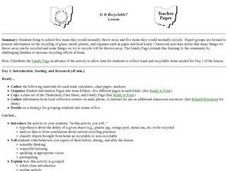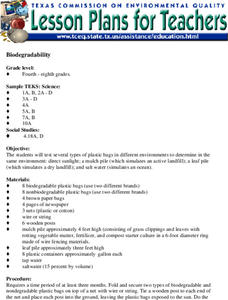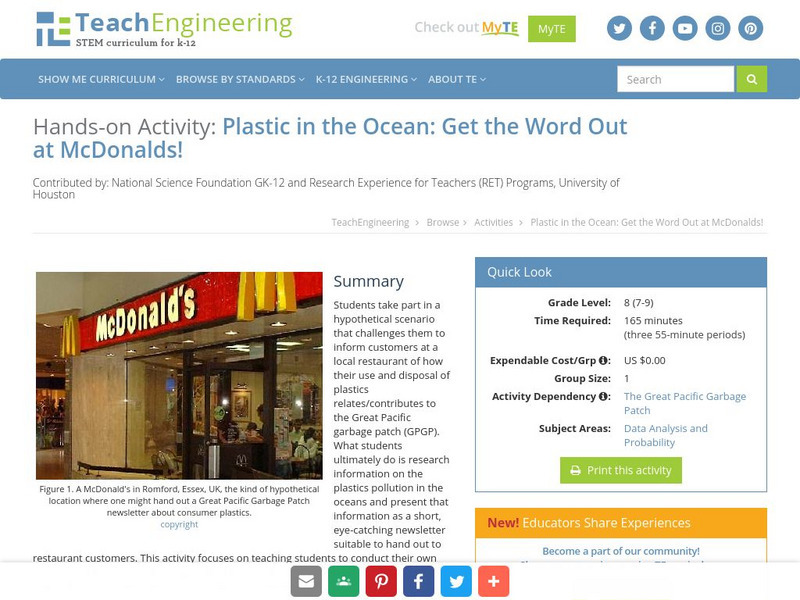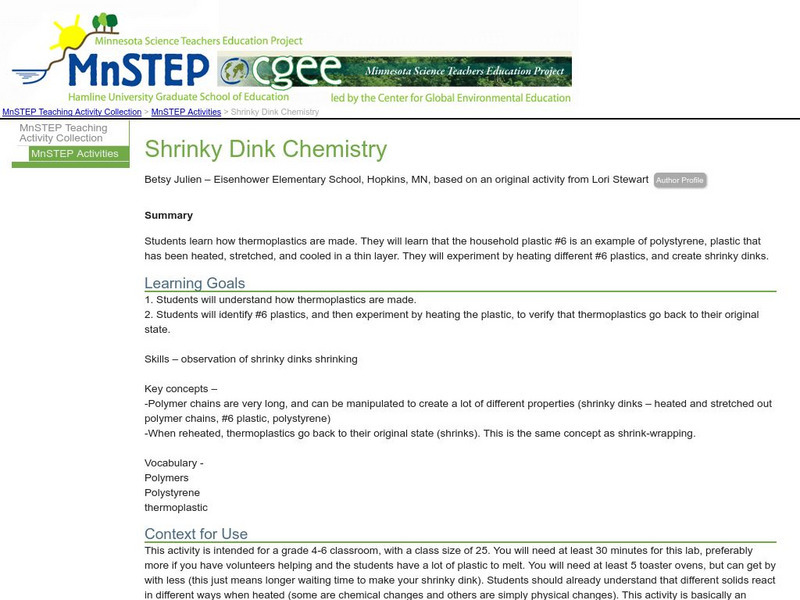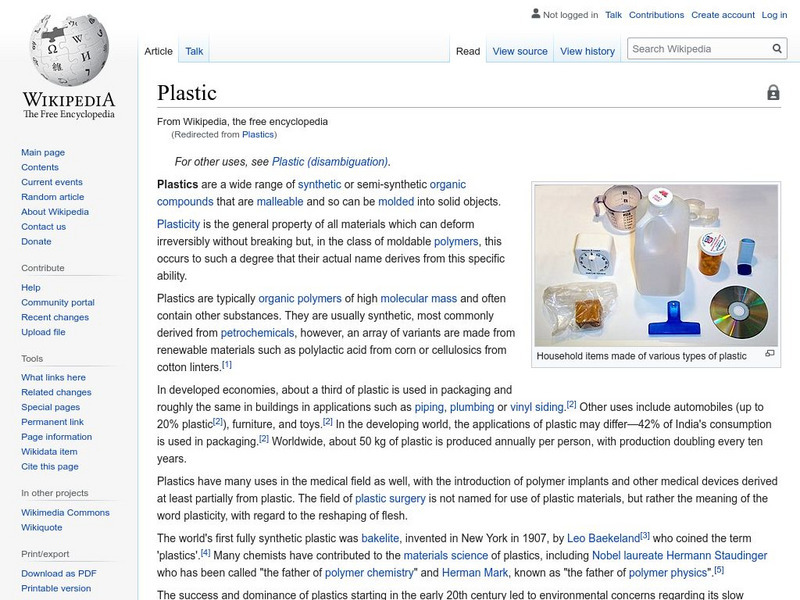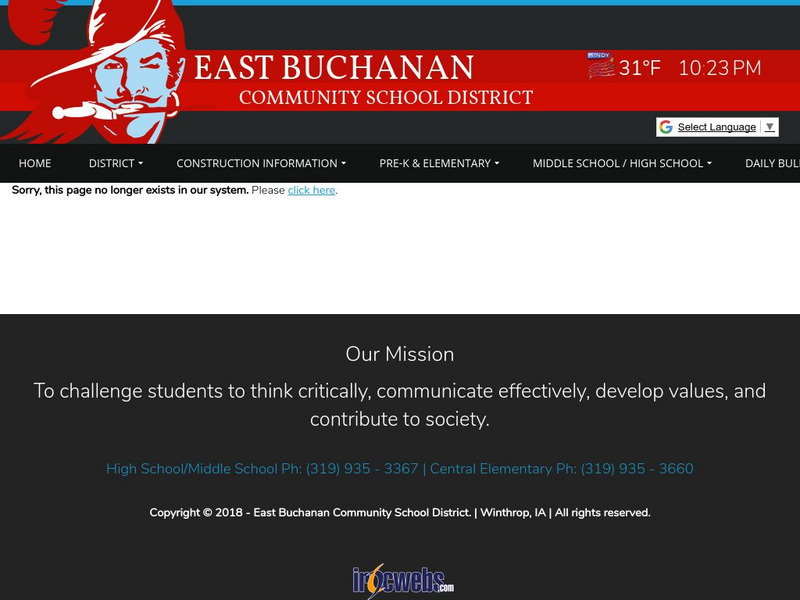Curated OER
Simply Sediments
In this earth science worksheet, students use a plastic bottle and sediments from their community to create a sediment bottle. They identify what types of sediments they locate. Students also identify which ones float and which ones move...
Curated OER
Is It Recyclable?
Students bring to school five items they would normally throw away and five items they would normally recycle. Expert groups are formed to present information on the recycling of glass, metal, plastic, and organics such as paper and...
Curated OER
Biodegradability
Students test a variety of plastic bags to test its biodegradability. They record their observations and discuss them once the experiment is complete. They identify materials best suited to be placed in a landfill.
Curated OER
Exploring the Physical and Chemical Properties of Polymers
Young scholars determine the physical and chemical properties of polymers. In this chemistry lesson, students test them for biodegradability. They collect data and compare their results.
Curated OER
How Are Polymers Utilized in Everyday Life?
Students identify the different types of polymers. For this chemistry lesson, students research information about an area of polymer science they chose. They create a PowerPoint presentation to share their findings in class.
Curated OER
Plastics and Rubber: What's the Difference?
Students classify household items into either plastic or rubber. In this chemistry lesson, students justify their classification system. They explain the difference between observation and inference.
Curated OER
Mystery Polymers
Middle schoolers examine how some natural substances are polymers. In this polymer lesson students complete a lab and give examples of a physical change.
Curated OER
Designing a Flotation Strategy for the Purification of Recycling
Twelfth graders work in teams to design a method of recycled plastics purification by flotation. They base their design on the concept that different kinds of plastics have different densities and keep overall costs and purification time...
Curated OER
The Polymer Schoolhouse
Students investigate polymers by discovering and examining plastics and creating a diorama.
Curated OER
Remote Sensing
Students focus on the history of remote sensing by reading an online article and pretending they are part of a remote sensing satellite.
DOGO Media
Dogo News: Week of 4 18 16: Edible Cutlery
Read about edible cutlery, and how it may help to reduce plastic waste. Includes video.
Other
American Chemistry Council: Plastics: Plastics 101
This resource provides detailed general information about plastics.
TeachEngineering
Teach Engineering: Get the Word Out at Mc Donalds!
Students take part in a hypothetical scenario that challenges them to inform customers at a local restaurant of how their use and disposal of plastics relates/contributes to the Great Pacific garbage patch (GPGP). What students...
TeachEngineering
Teach Engineering: Where Are the Plastics Near Me? (Field Trip)
An adult-led field trip allows students to be organized into investigation teams that catalogue the incidence of plastic debris in different environments. These plastics are being investigated according to their type, age, location and...
TeachEngineering
Teach Engineering: Where Are the Plastics Near Me? (Mapping the Data)
In a student-led and fairly independent fashion, data collected in the associated field trip activity are organized by student groups to create useful and informative Google Earth maps. Each team creates a map, uses that map to analyze...
TeachEngineering
Teach Engineering: Bridging to Polymers: Thermoset Lab
Students act as engineers to learn about the strengths of various epoxy-amine mixtures, and observe the unique characteristics of different mixtures of epoxies and hardeners. Student groups make and optimize thermosets by combining two...
TeachEngineering
Teach Engineering: Close Encounters of the Polymer Kind
Students explore the basic characteristics of polymers through the introduction of two polymer categories: thermoplastics and thermosets.
Scholastic
Scholastic History Mystery: Twentieth Century Inventions: Plastic
Students try to guess the mystery subject Carlotta Facts, the History Mystery Museum's professor, is studying. They read the clues, do some online and offline research, and then attempt to identify the game's mystery subject, the...
Science Education Resource Center at Carleton College
Serc: Mn Step: Shrinky Dink Chemistry
In this lesson, students first learn about thermoplastics, and about polystyrene in particular, which is a #6 plastic. They will then heat different #6 plastics to create shrinky dinks. As they are heated, they shrink, which is a...
Wikimedia
Wikipedia: Plastic
Wikipedia offers all of the basic information one would need about the topic of plastic. Includes hyperlinked table of contents for easy site navigation.
Society for Science and the Public
Science News for Students: Plant Powered Plastics
Discusses plastic products, what they are made from, their impact on the environment and on human health, and alternative plastics being created using plants, as well as the advantages of these new products.
Other
Leo Hendrik Baekeland
An in-depth look at the life of Leo Hendrik Baekeland, including his creation of the first completely synthetic plastic, bakelite.
Other
Engineers Edge: Strenght of Materials
This site has information about the strength of materials. Covers various types of stress and yeilding. Formulas included.
TED Talks
Ted: Ted Ed: The Nurdles' Quest for Ocean Domination
Nurdles are the tiny, factory-made pellets that form the raw material for every plastic product that we use, from toys to toothbrushes. And while they look pretty harmless on land, they can really wreak havoc on our oceans. Kim Preshoff...



